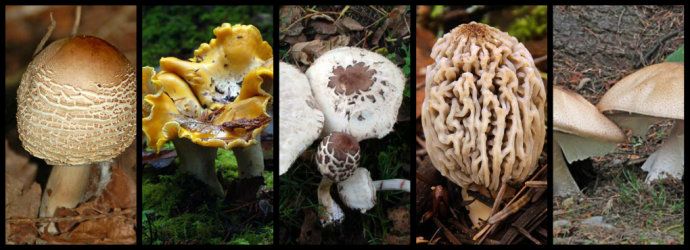
11月初,报名参加了一个识别野生蘑菇的活动。由两个有经验的导游带领我们在HolleyBurn Mountain 的森林里,边找寻蘑菇边介绍。在步行道两旁、小溪旁边、倒下的树干上、树根周围、树荫下、野草丛中、落叶里,到处生长着不同品种的蘑菇,我们看到一个,导游就介绍一个,两个多小时的活动,也学到不少的关于蘑菇的知识。
识别蘑菇的方法有多种,最基本的方法,一是要看生长地带:可食用的无毒蘑菇多生长在清洁的草地或一些树木上;二是看颜色:一般情况下,有毒蘑菇菌面颜色鲜 艳,采摘后易变色;三是看形状。无毒蘑菇的菌盖较平,伞面平滑,菌面上无轮,下部无菌托,有毒的蘑菇菌盖中央呈凸状,形状怪异,菌面厚实板硬,菌秆上有菌 轮,菌托秆细长或粗长,易折断;四是闻气味:无毒蘑菇有特殊香味,有毒蘑菇有怪异味。以上只是最基本的,如果要识别陌生的蘑菇,还要进行其他一系列的鉴 定:测试、煮试及化学鉴别等。
这次活动的另一个收获就是不要随便的食用野生蘑菇!这两位导游特别提醒大家,不确定的蘑菇千万不要采摘,有些毒蘑菇看起来和一些食用蘑菇很相似,如果不小 心食用了,会中毒甚至导致死亡!有些蘑菇的中毒症状是马上的,但有些会推迟到几天以后出现。有的蘑菇不会有中毒现象,但如果喝酒或吃了其他的特别的食物会 导致中毒。
在远足、登山时,总能发现很多不同形状、不同颜色的蘑菇,看着它们像肉嘟嘟的花儿,特别喜欢给它们拍照。过去,因为不了解它们,只敢看、拍照不敢碰. 现在对它们有一些了解,还是只敢看、拍照不敢碰, 但依然很喜欢它们......


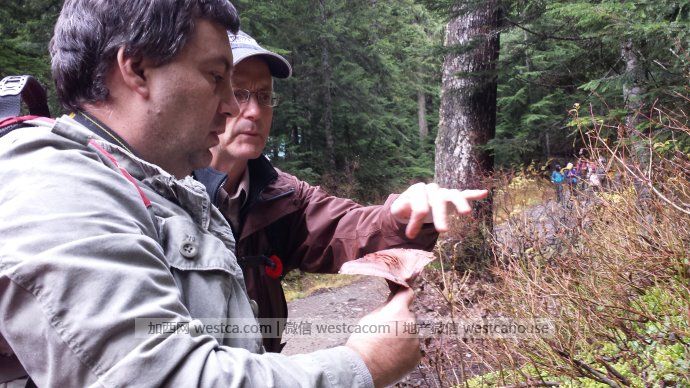
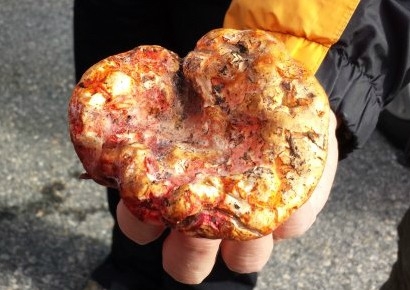
这个是red lobster mushroom龙虾蘑菇,闻起来有浓浓的龙虾的味道。这种蘑菇比较难找到.
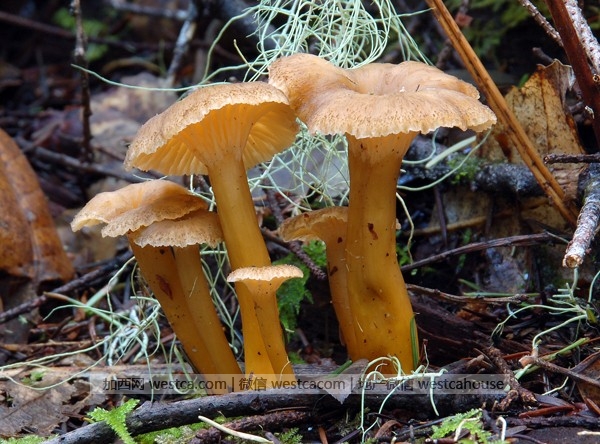
这个小小的蘑菇是Winter or Funnel Chanterelle,称冬季鸡油菌,是可以食用的。
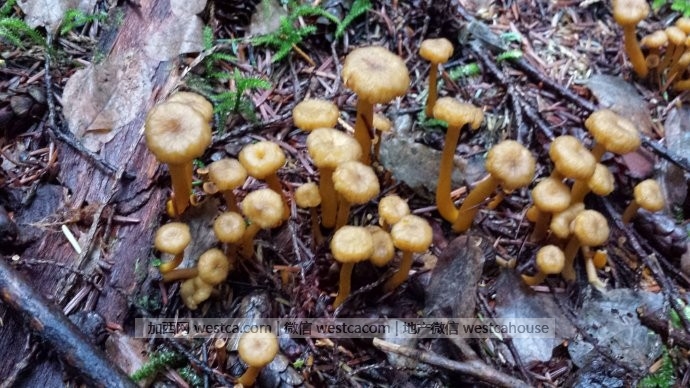
那天看到很多成片的鸡油菌.
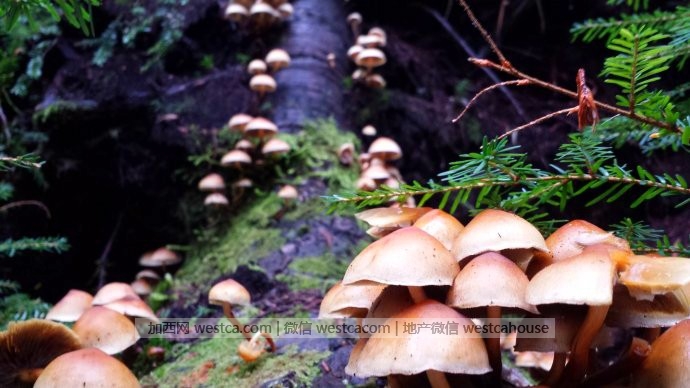
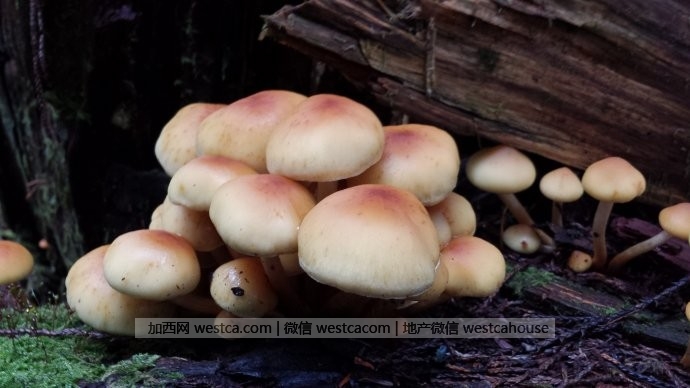 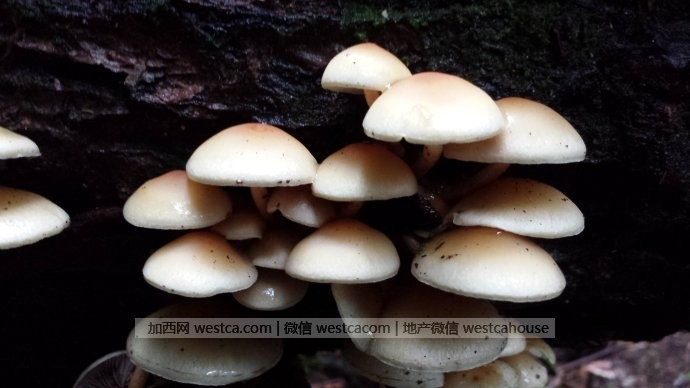 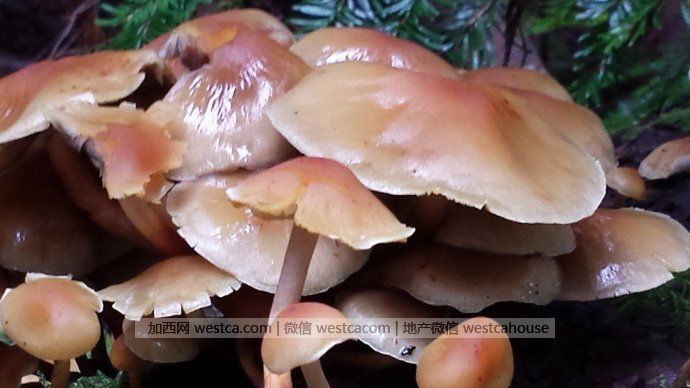
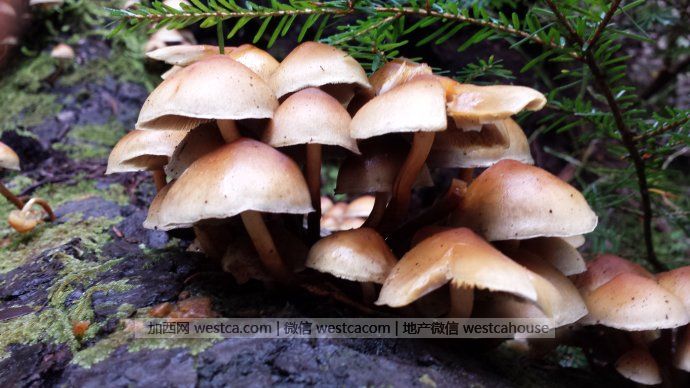
沿着树干长满了这些可爱的蘑菇,只可欣赏,不可食用。

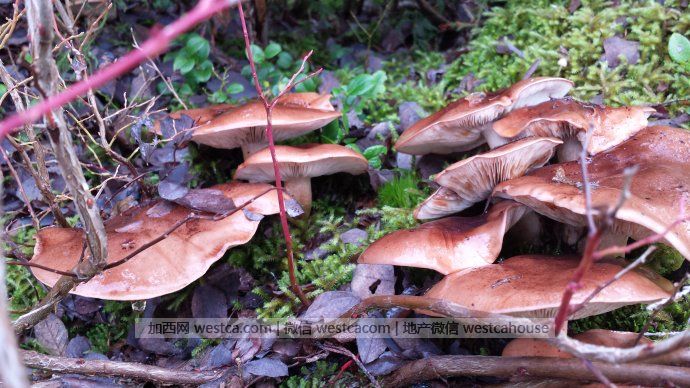
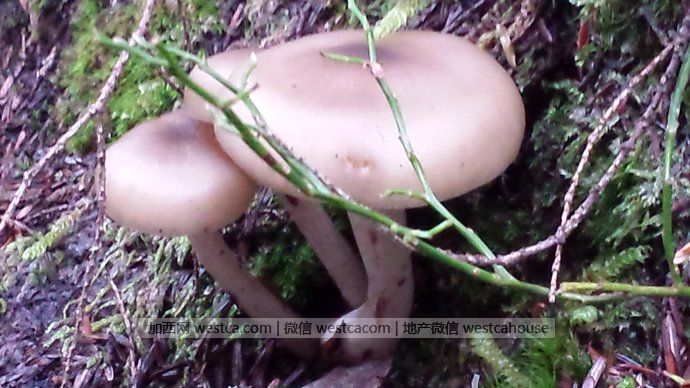
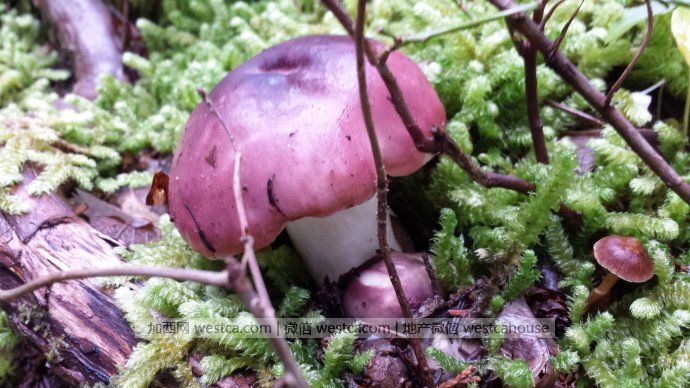

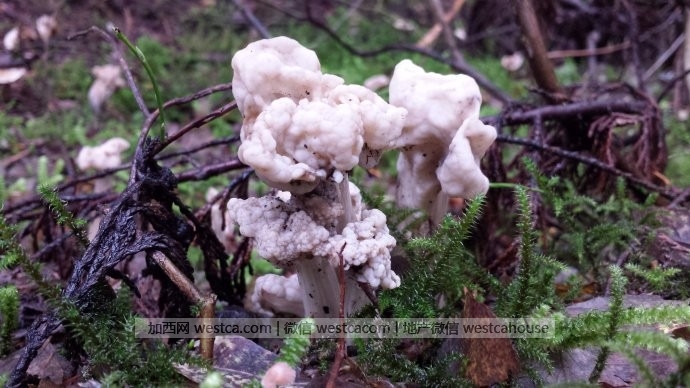
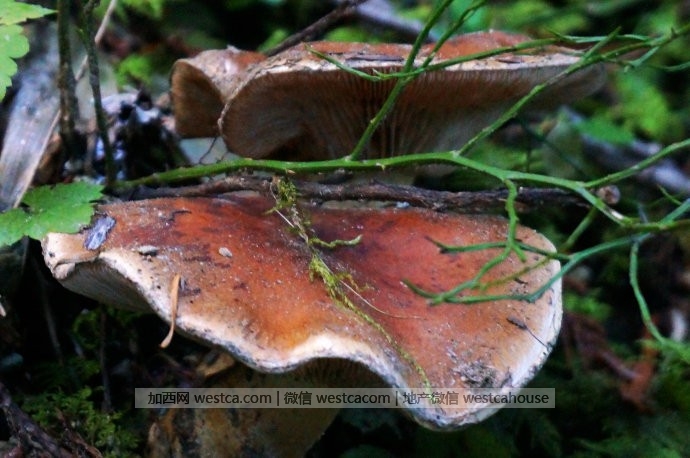
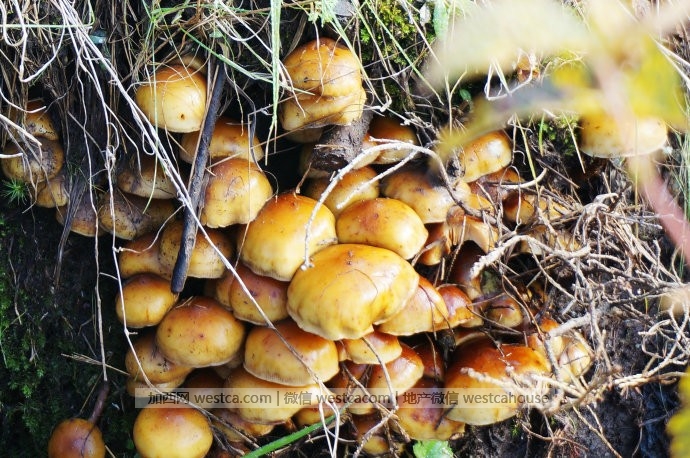
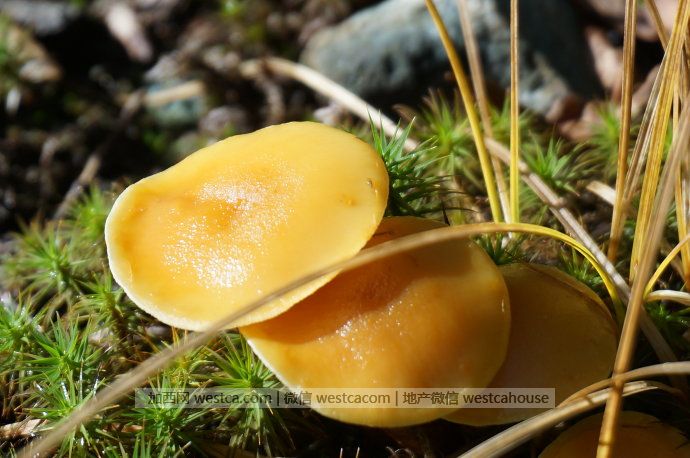

这个漂亮的花蘑菇很明显是有毒的,不可食用.
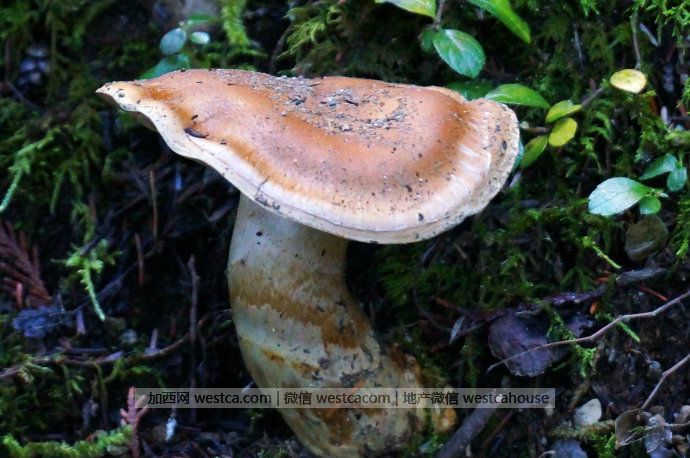
##############################################################
下面从网上摘录了一些北美西海岸常见可食用野生蘑菇的基本信息,仅供参考:
This guide provides a list of edible mushrooms in the Pacific Northwest including Oregon, Washington, and British Columbia.
This list only contains "safe" mushrooms - those that can be reliably identified and have no deadly-poisonous lookalikes. As a safety precaution, all mushrooms should be cooked and eaten in small quantities if not previously consumed.
Warning: do not attempt to identify a mushroom by matching the pictures alone; compare all the listed characteristics. Never experiment with a mushroom that you cannot positively identify. A poisonous mushroom can kill you.
Apricot Jelly Mushroom
Guepinia Helvelloides
fruiting body is up to 6cm wide, salmon-pink to rose. flesh is smooth, genatinous, and malleable. stem base has regions of white mycelium. appears in spring, summer and fall. grows as several to many after rainy periods in areas with conifers. has a pleasant taste with no odor; cook before eating.
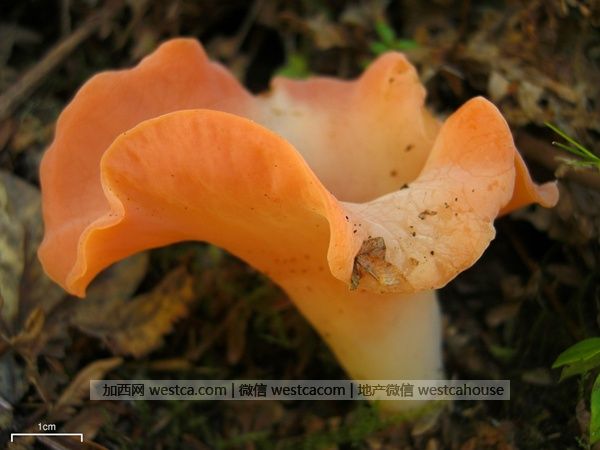
Bear's Head Tooth Mushroom
Hericium Americanum fruiting body is 10-30cm wide, white, turning yellowish with age. fungus branches from a thick stipe that is attached to the wood. branch-tips bear many long white spines hanging downward. appears in late summer and fall. grows on hardwood and conifer logs. has a nutty taste and mild odor; cook before eating.
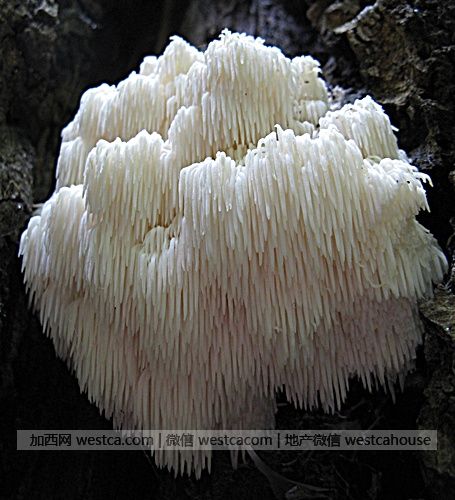
Black Morel
Morchella Elata
cap up to 8cm wide, hollow inside with characteristic honeycomb surface consisting of black/brown ridges and dark brown pits, darkening with age. stem is white, smooth, irregular and hollow. bottom of cap does not hang loose but is joined to the stem. grows single or numerous on the ground, usually near conifers. appears in early spring. mild pleasant taste and odor; cook before eating. tip: morels are variable shape, size and color (white/gray/yellow/brown/black), but are characterized by their distinctively shaped caps that do not hang loose and their hollowness; all morels are prized edibles. warning: may be poisonous if consumed with alchohol. warning: do not confuse with a False morel, which is not hollow inside and has a cap attached at the top of the stalk rather than a continuous hollow chamber.
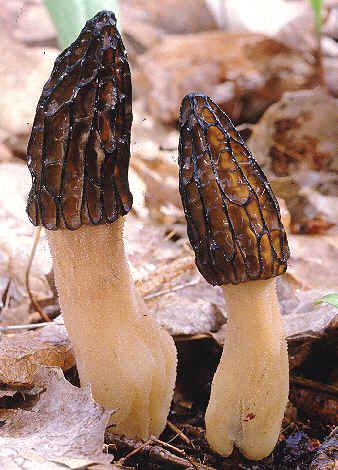
Blue Chanterelle
Polyozellus Multiplex
caps are up to 10cm wide, flat, smooth, dark purple to blue/black with incurved edges. fruiting body is funnel-shaped. outside of the mushroom is pale violet with small ridges running down almost to the base. flesh is thick, soft, blue to black. stems are fused together. appears in sumer and fall. grows in large, dense clusters under conifers such as spruce and fir. taste is mild and pleasant, with an indistinct odor; cook before eating.

Cauliflower Mushroom
Sparassis Crispa
fruiting body is up to 30cm wide, white or yellow/brown tinted, shaped like a cauliflower head with a spongy, curly rosette exterior. has no visible stem, gills, tubes, pores or spines. flesh is white, firm, with many branches arising from a hidden central stalk. appears in the late summer and fall. grows singly or in small groups on the ground at or near the base of conifers. has a mild, pleasant taste and indistinct odor; cook thoroughly before eating, younger specimens are preferred. an edible look-alike is Sparassis spathulata, which is similar in appearance but has multiple anchor points to the ground.
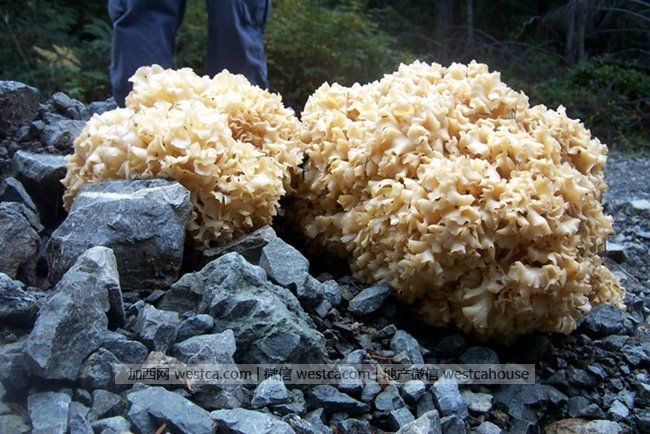
Chicken Of The Woods
Laetiporus Sulphureus
fruiting bodies are up to 20cm wide, shelf-like, rubbery, sulphur yellow to orange, sometimes with bright orange tips. older specimens become pale and brittle, chalk-like. flesh is white to yellow tinted, firm, softer towards the edges. underside is characteristically white to bright yellow, with tiny pores instead of gills. has no stem. grows in overlapping groups on logs, stumps, or wounds of trees. appears in spring, summer, and fall. has a mild taste and odor; cook before eating. an inedible (but not poisonous) look-alike is Pycnoporus cinnabarinus, which is corky/rigid rather than rubbery, and orange/red on the top and underside, rather than bright yellow on the underside. an inedible (but not poisonous) look-alike is Hapalopilus nidulans, which is cinnamon brown/orange on the top and the underside, rather than bright yellow on the underside. tip: harvest the soft outer margin of the younger specimens to avoid bitterness. warning: can cause allergic reaction in some people due to toxins absorbed from the tree; begin by sampling small amounts.

Comb Tooth Mushroom
Hericium Coralloides
fungus is white, 10-30cm wide, turning yellowish with age. fungus branches from a thick stalk that is attached to the wood. branches have short white spines along their lengths. appears in late summer and fall. grows on conifers and hardwoods. has a nutty taste and mild odor; cook before eating.

Common Puffball
Lycoperdon Perlatum
fruiting body is up to 6cm wide, pear-shaped, white to dull white, with small conical spines that break off but leave a network of spots behind. flesh must be firm and all-white. flesh must be undifferentiated with no trace of gills, no thick rind and no outline of mushroom visible in cross section. appears in the summer and fall. has a mild taste with no odor; cook before eating. a non-poisonous look-alike is Lycoperdon foetidum, which is similar in appearance but are brown/greyish-beige rather than white and has an unpleasant odor. grows singly, in groups or clumped together on forest beds under conifers and hardwoods. a look-alike with unknown edibility is Lycoperdon umbrinum, which is similar in appearance but are brown/tan rather than white. warning: do not confuse with young specimens of the deadly Destroying Angel or other poisonous white mushrooms, which have no spines and have faint differentiation inside rather than being solid white.
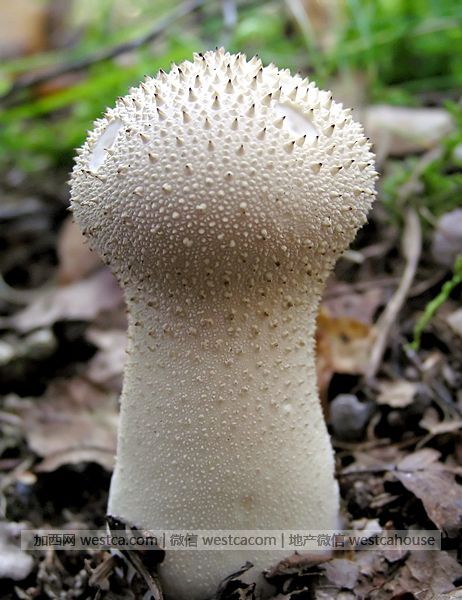
Fairy Ring Mushroom
Marasmius Oreades
cap up to 6cm wide, convex, smooth, tan to light brown. older specimens have flying-saucer shaped caps, often slightly darker on the central hump. flesh is thin, white. gills are broadly attached to the stem, tan, well-spaced, veined. stem is solid, NOT hollow, and characteristically tough - able to wrap around your finger without breaking. Smooth, dry, tan, darker brown/red and hairy at the base, lacking a partial veil. grows in grassy areas, meadows and fields, forming partial or complete rings. appears in spring, sumer or fall. taste is mild and pleasant; cook before eating. warning: avoid specimens growing near highways, which may contain toxic car exhaust compounds.
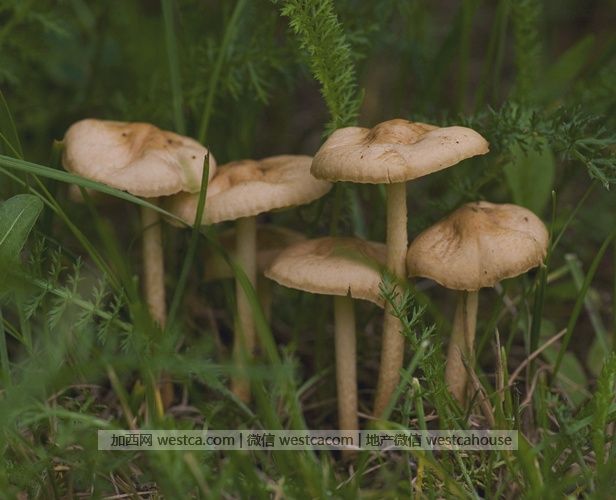
Field Notes
The Fairy ring mushroom is my personal favorite. They seems to be everywhere, they're tasy, easy to identify, and with some patience you can really gather quite a lot of these insignificant-looking fellows. As a city-dweller, you'll likely find this mushroom after rainy periods every time you walk around outside and look for it, it's very common on lawns where it grows in rings and often discolors the grass around the perimeter. When you find a fairy-ring, don't assume it's the edible variety until you check the stem and gills, because there are superficial look-alikes. The stem should be solid and remarkably strong. You'll have no trouble pulling up the entire mushroom (and maybe its neighbour) just by squeezing the stem and pulling. Next, make sure the gills are not crowded, but are well spaced and feel a little rubbery. When you smell the mushroom, you'll smell nothing, or maybe a faint non-mushroomy odor like sawdust.
I recommend going into the field with scissors for collecting these mushrooms. Snip the cap off the stem and then cut the cap right in half and check for worm holes in the hump of the cap. You'll discard about 50% of the mushrooms until you learn to spot the healthier ones. After you wash the mushrooms, I recommend either cooking with them fairly soon or preserving them. Anything you don't cook you should either freeze or thoroughly dry out. These mushrooms preserve well and taste just fine, they are one of the best kept secrets of city foraging.
Golden Chanterelle
Chanterelle
Cantharellus Cibarius
cap is up to 15cm wide, depressed in the center, smooth, dry, uniform egg-yolk yellow. mature specimen is funnel shaped, immature specimens should be avoided. forking ridges (rib-like folds) are present rather than gills; they descend onto the stem. flesh is firm, yellowish, does does not change color when bruised. stem is solid, orange tinted, tapering slightly to the base. grows solitary or in groups on the ground, but not clustered at base of trees, and never on wood. appears in the summer and fall. has a pleasant, mild taste and mild, fruity odor; cook before eating. an edible look-alike is the Smooth chanterelle (Cantharallus lateritis), which is similar in appearance but grows under oaks, has a pinkish hue and reduced ridges. warning: do not confuse with the poisonous False Chantarelle (Hygrophoropsis aurantiaca), has gills rather than ridges, often grown on decaying wood, tastes foul and causes stomach upset. warning: do not confuse with the poisonous Jack-O'Lantern Fungus (Omphalotus illudens), which grows in large clusters on roots, stumps, or at the base of trees and has an unpleasantly sweet odor.
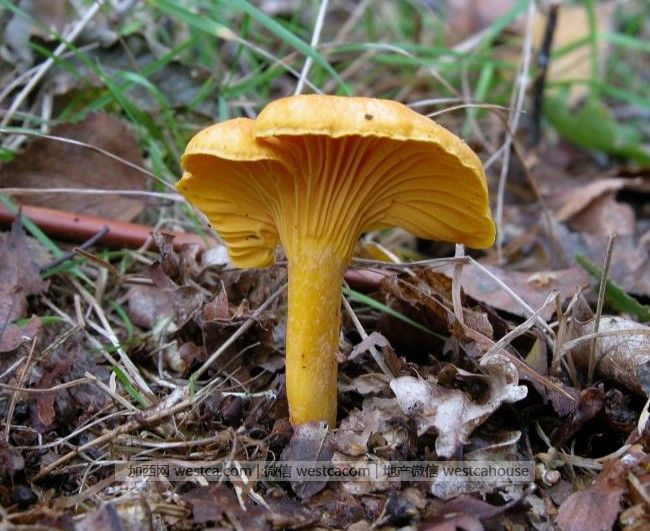
Hedgehog Mushroom
Hydnum Repandum
cap is up to 10cm wide, convex, smooth, dry, wavy at the edges, light brown with an orange tint. underside has distinctive spines that are cream-colored. flesh is white when cut, coloring unevenly to yellow-brown. stem is solid, white, possibly enlarging slightly towards the base. grows solitary or numerous on the ground in areas with conifers and hardwoods. appears in the summer and fall. has a pleasant taste with no odor; cook before eating. an edible look-alike is Hydnum umbilicatum, which is similar in appearance but smaller and with a darker cap, growing in bogs and swamps. an inedible (but not poisonous) look-alike is Bankera fuligineo-alba, which is similar in appearance but instead of a smooth cap has one with embedded pine needles and organic debris.
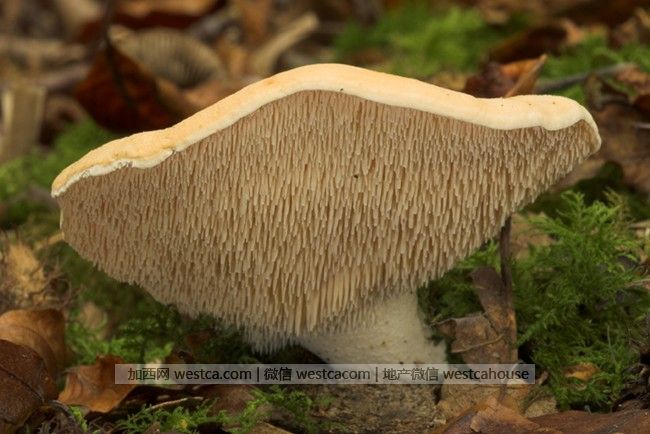
Hexagonal-pored Polypore
Polyporus Alveolaris
cap is up to 8cm wide, cream-orange to brownish-red. underside is whitish and has characteristically large hexagonal, almost diamond shaped pores, each ~1mm wide. grows singly or as several on hardwood branches and twigs. appears in sumer or fall. has mild taste and no odor; cook before eating, softer young specimens are preferred. an edible lookalike is Polyporous squamosus.

Horn Of Plenty
Black Chanterelle , Black Trumpet
Craterellus Cornucopioides
cap is up to 8cm wide, with a hollow tube-like depresson, dark brown or soot-grey/black. in older specimens the cap margins are wavy/split, otherwise they are rolled out. fruiting body is funnel-shaped with smooth-looking but slightly wrinkled outer surface that is smokey grey with a lilac tint, and extends almost to the base. stem is very short, hollow, brown. grows on the ground grouped together under conifer/hardwood stands. appears in the early summer and fall. has a mild/pleasant taste and odor; cook before eating. an edible look-alike is Craterellus fallax, which is practically identical but has an orange spore print rather than whitish.
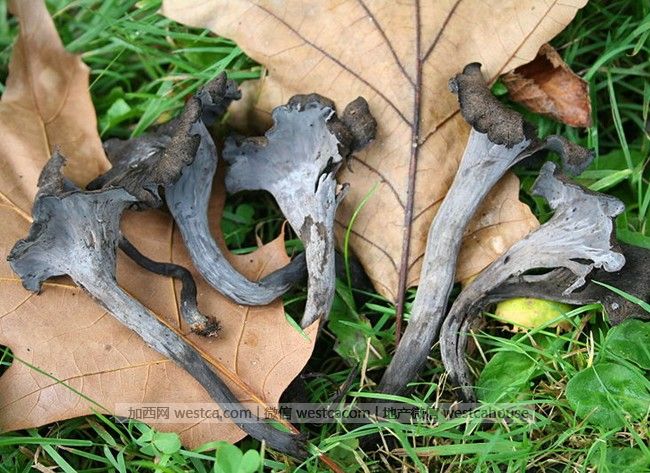
Horse Mushroom
Agaricus Arvensis
cap up to 20cm wide, convex, smooth, dry, white to creamy, with NO hint of orange. older specimens have a planar cap with light brown scales in center. flesh is white or cream, firm. gills are crowded, free from the stem, progressing from pink-tinged white to dark brown/black with age. stem is smooth, dry, equal or thickening towards the base, unchanged when bruised. No yellow staining at the base of the stem when cut ot bruised. in young specimens, the underside of the partial veil bears a characteristic cogwheel-like pattern. in older specimens, the double veil progresses to a skirt-like tissue/ring around the stem. grows in grassy areas, meadows and fields. appears in late sumer or fall. taste is mild, with a light licorice/anise odor; cook before eating. an edible look-alike is Agaricus silvicoa, which is practically indistinguishable in the field. warning: do not confuse with the poisonous Agaricus xanthodermis, which is similar in appearance but has a stem that buises yellow at the base when cut or bruised. warning: only collect younger specimens that still have the characteristic cogwheel pattern on the unbroken veil; older specimens could be confused with poisonous look-alikes.
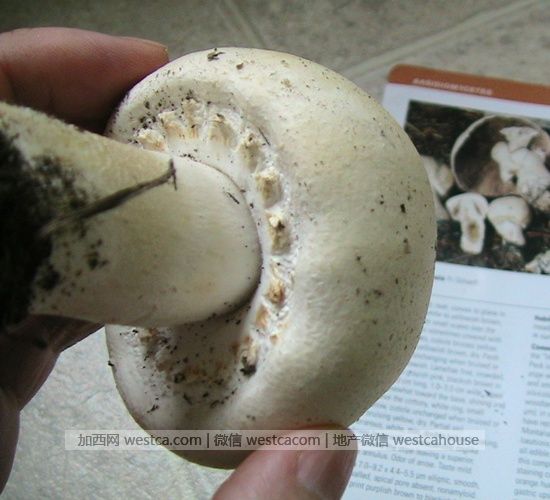
Field Notes
It's always exciting to find an unopened white mushroom, turn it over, and see the defining cog-wheel pattern of the horse mushroom. This is a common mushroom that you can find after rainy periods on city lawns and grassy areas, with a little luck. Aside from the cog-wheel pattern, it superficially resembles the similarly-common Meadow mushroom, although the gills are nowhere near as pink, and the flesh on the Horse mushroom is firmer and more water resistant, with an odor that's all its own. Ensure that the stem base does not discolor to yellow and that the mushroom is worm-free. I generally slice these thinly and fry them in butter and/or a pesto sauce, adding water until the mushroom has been cooked through.
Ink Cap
Coprinopsis Atramentaria
cap is conic to bell-shaped with age, up to 8cm wide, light gray or gray-brown with furrow-lines radiating to the margins. gills are nearly free from the stem and white/grey when young. the flesh and gills of older specimens liquefies into a black inky mass. partial veil leaves an inferior, fibrous ring on the white stem. grows in tight clusters in grass or on wood debris. appears in sumer and fall. has a mild taste with no odor; cook before eating. tip: collect younger specimens and/or remove blackening areas which have a more bitter taste. tip: cooking with water shortly after collecting helps to prevent the dish from turning into a black inky mess. warning: causes a toxic reaction of hot flushing and nausea if consumed with or followed by alcohol.
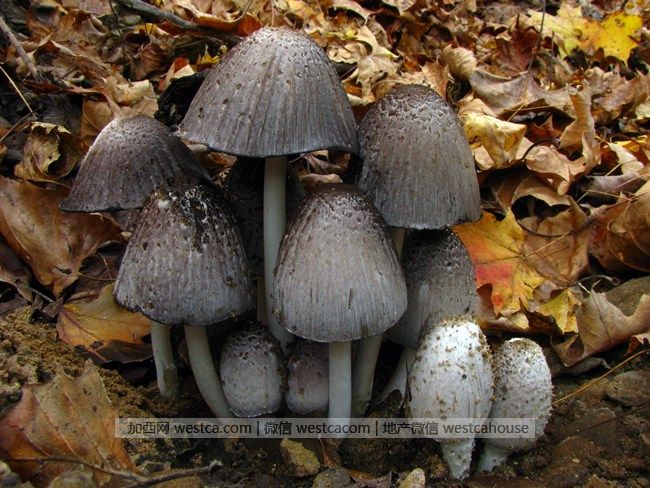
Jelly Ear
Wood Ear
Auricularia Auricula-judae
fruiting body is is up to 15cm wide, ear-shaped, rubbery, orange-brown to muddy red/brown. upper surface is smooth, possibly with ribbing on the underside. flesh dries tough and hard. grows in groups on conifers and logs, sometimes including hardwoods. appears in early spring, sumer and fall. flavour is mild with no odor; cook before eating.
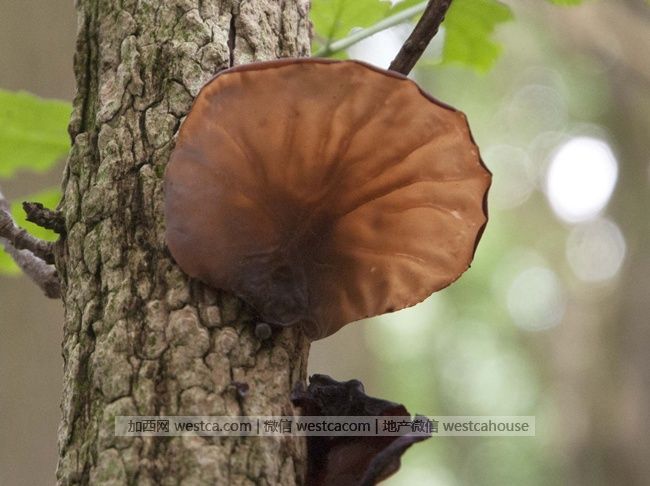
King Bolete
Cepe
Boletus Edulis
cap is up to 35cm wide, convex, reddish to yellowish brown, smooth but often uneven. underside of cap consists of pores, off-white to olive in age, with no pink tinge. flesh is white; flesh and pores unchanging when bruised. stem is white or tinted yellow/brown with a characteristic fine, white network extending down from the top of the stem, variable in shape. partial veil absent. grows singly or as many in conifer and hardwood stands. appears in spring, summer and fall. has a mild and pleasant taste with no odor; cook before eating. tip: boletes are mushrooms that grow on the ground and have a sponge-like surface on the underside of the cap - tiny pores, rather than gills. There are no deadly-poisonous boletes, though some varieties can cause nausea/vomiting. An unknown bolete is safe if it does not bruise blue after being cut, is not red on the underside of the cap, and does not taste foul. Small amounts should be consumed when testing an unfamiliar bolete.
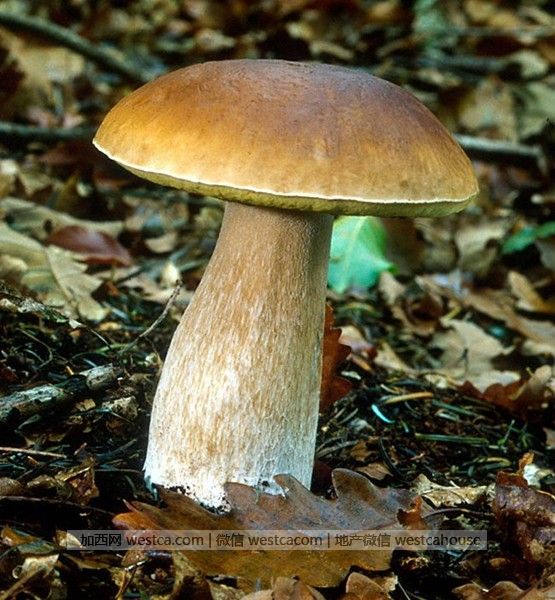
Larch Bolete
Suillus Grevillei
cap is up to 15cm wide, convex, golden yellow to orange-red, smooth, sticky, slimy when wet. older speciments are deep chestnut-red. underside of cap consists of yellow tubes arranged radially that bruise brown. flesh in cap flushes faintly lilac. young specimens have partial veil developing to a yellow/red ring on the stem. has solid stem, possibly widening at the base, yellowish above the ring and streaky reddish/brown below. intermediate/mature specimens have a faint net pattern above ring. grows in groups near larch trees. appears in summer and fall. has a mild taste and odor; cook before eating. tip: boletes are mushrooms that grow on the ground and have a sponge-like surface on the underside of the cap - tiny pores, rather than gills. There are no deadly-poisonous boletes, though some poisonous varieties can cause nausea/vomiting. An unknown bolete is safe if it does not bruise blue after being cut, is not red on the underside of the cap, and does not taste foul. Small amounts should be consumed when testing an unfamiliar bolete.

Lion's Mane
Hericium Erinaceus
fruiting body is up to 40cm wide, a white oval-shaped mass of long white spines, each up to 3 cm long, yellowing in age. flesh is firm/spongey and anchored to the tree by a solid white stem. grows singly from wounds on hardwoods. appears in late sumer and fall. flavour is mild and pleasant with a mushroomy odor; cook before eating. an edible look-alike is Hericium abietis, which is similar in appearance but lightly salmon-coloured with more branching and a larger size.
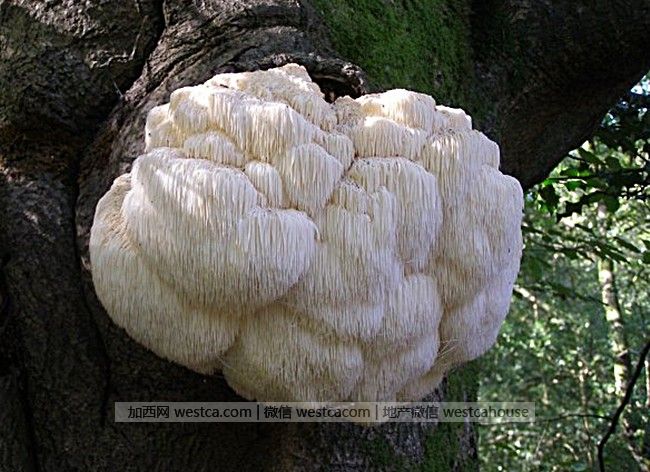
Lobster Mushroom
Hypomyces Lactifluorum
not a mushroom, but a parasitic fungus that grows on mushrooms. the fungus turns the host mushroom a bright reddish orange. the fungus deforms the surface of the host mushroom to be coarse, cracked, and dotted with tiny white pimples. the fungus eventually twists the mushroom into an irregular shape, making the host unidentifiable. has a seafood-like flavor that is highly variable. has a firm, dense texture. fresh specimens have a white interior. appears in summer and fall following rainy weather. has no poisonous look-alikes. Unclear whether it's technically possible for the fungus to be hosted on a poisonous mushroom; presently there is no evidence of this occuring.
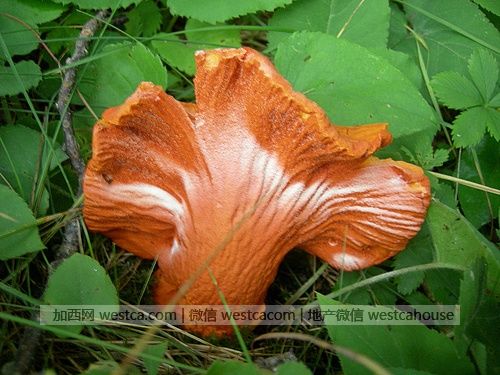
Meadow Mushroom
Agaricus Campestris
cap up to 10cm wide, convex, white to creamy, dry, smooth. older specimens have a nearly planar cap and can be dingy white to cinnamon brown. flesh is white, firm, possibly with a brown tint. gills are crowded, free from the stem, progressing from characteristically pink to chocolate brown with age. stem smooth, white, equally wide, dry, smooth above the ring with loose fibrils near the base. Slowly bruises off-white, to dingy brown, NOT staining yellow, orange or red. partial veil is smooth, white, progressing to a brown ring. grows in grassy areas, meadows and fields, often in a ring. appears in spring, sumer, or fall. taste is mild, odor is pleasant; cook before eating. an edible look-alike is Agaricus bisporus, which is the commercial white mushroom found in grocery stores. warning: discard specimens that do not have the distinctly pink gills or who's flesh stains yellow, orange, or red; these can be poisonous look-alikes. warning: white mushrooms must always be treated with extra caution and attention to detail, there are a number of deadly poisonous species.
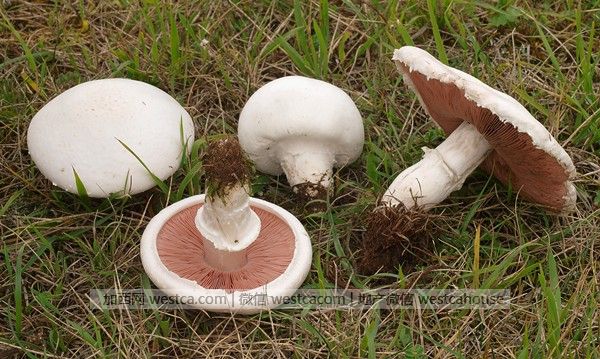
Field Notes
This is one of the most common mushrooms in the short-list of fungi that you can enjoy as a weekend/city-lawn forager. Play it safe and only take those with gills that are still pink. The pinkness should be distinctive (think salmon pink, not just light brown maybe-kinda pink). But don't forget that pink/red (or yellow or orange) is BAD if you see that in the stem after it's been cut. The odor should remind you of the pleasant mushroomy smell of grocery-store white mushrooms, maybe even better! Be super-vigilant with white mushrooms; if there is any doubt about all the characteristics matching, leave it. Prepare and cook as with the store-bought variety.
Mica Cap
Coprinellus Micaceus
cap is conic to bell-shaped with age, up to 6cm wide, dry, with light brown with furrow-lines radiating to the margins. young specimens often have glistening particles on the cap. gills are nearly free from the stem and white/grey when young. the flesh and gills of older specimens liquefies into a black inky mass. stem is silky white, hollow, smooth with no partial veil. grows in tight clusters in grass or ground covering wood debris during cool, wet weather. appears in spring, sumer and fall. has a mild taste and odor; cook before eating. tip: younger specimens which still have white gills are preferred. tip: washing with water shortly after collecting and storing them wet in tupperware helps to prolong their lifespan. warning: may cause an adverse reaction if consumed with alcohol consisting of hot flushing, nausea, headaches, and/or vomiting.
Pictures (9)
previous picture | next picture >>
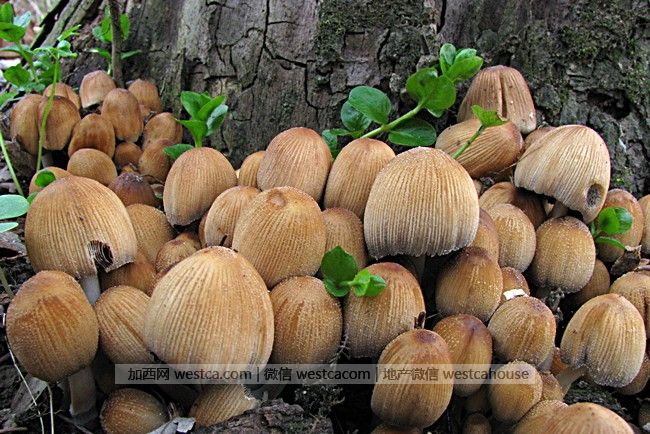
Field Notes
You can find Mica caps anywhere that wood is rotting away beneath the soil, including city lawns. And if you find a good patch of them, you can revisit the spot repeatedly as more pop up, typically after cooler rainy periods. They are frail, meager little mushrooms, but one of my favorites because they're fairly easy to identify and seem to have no troubles of the insect/wormy kind.
One of the features to watch for is the crowded way they grow together, with the stems arising from a common point and the caps really crowding against each other. If the caps check out (radially striate, etc), check for the youngest mushroom around - the gills should be white. Then check for the oldest mushroom around - it should be turning unmistakably black and inky as it withers away starting from the cap adges. If none of the mushrooms are that old, pay attention when you cook the mushrooms - if they don't turn the entire pan obviously black with ink, you've chosen a non-inky look-alike (discard!). Although there is conflicting information about whether Mica caps can be consumed with alcohol (may cause flushing, vomiting, not lethal), I would avoid it. I've added small amounts of wine to mica caps on the frying pan and experienced enough intestinal discomfort afterwards to remember the lesson; your own experience may vary.
Oyster Mushroom
Pleurotus Ostreatus
cap up to 8cm wide, fanlike convex shape, smooth, moist, cream to light brown. flesh is off-white, firm. stem usually not present, otherwise white, dry, with white hairs at base. usually grows in large overlapping custers, on trees, logs and stumps of hardwoods and conifers, never on the ground. appears in spring and fall. has a mild, pleasant taste and fragrant fruity odor; cook before eating. tip: the oyster mushroom has several looka-alikes that are indistinguishable in the field, all are edible as long as they grow on trees (avoid those growing on dead wood/logs/stumps). a potentially poisonous look-alike is the Angel wings mushroom (Pleurocybella porrigens), which is similar in appearance but is white rather than cream, has thinner flesh, no odor, and grows on dead wood (logs/stumps) rather than trees.
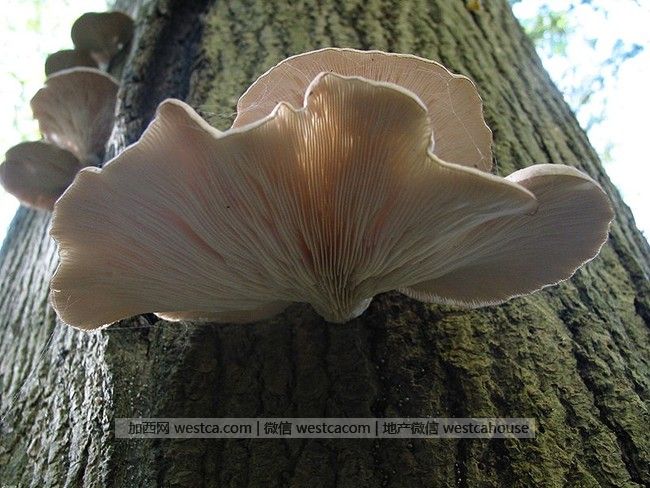
Red Cracked Bolete
Boletus Chrysenteron
cap is up to 11cm wide, convex, medium to dark brown with characteristic cracks and damaged pink patches that have a red tinge. older specimens have a planar cap with deeper cracks. underside of cap has yellow pores that buise blue or blue/green. flesh is white to reddish near the skin, slowly bruises blue or blue/green. stem is dull yellow, possibly streaked red, dry, often curved. appears in the spring, summer and fall. grows singly to numerous in conifer/hardwood stands. has a mild taste with no odor; cook before eating. tip: boletes are mushrooms that grow on the ground and have a spongy tubular surface on the underside of the cap - tiny pores, rather than gills. There are no deadly-poisonous boletes, though some poisonous varieties can cause nausea/vomiting. An unknown bolete is safe if it does not bruise blue after being cut, is not red on the underside of the cap, and does not taste foul. Small amounts should be consumed when testing an unfamiliar bolete.
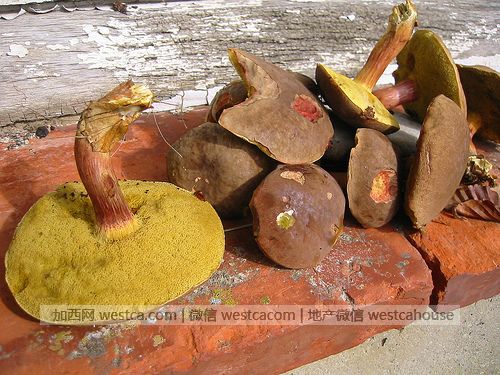
Rosy Gomphidius
Gomphidius Subroseus
cap is up to 5cm wide, convex shaped, smooth and sticky, pink to red in color. older specimens have a planar cap with upturned margins. flesh is white and firm. gills are white, graying in age, and descend onto the stem. stem is white above and below the ring with a distinct bright yellow area towards the tapering base. partial veil is thin, leaving a colorless ring on the stem that soon turns black. grows singly or abundantly in areas with conifers. appears in the spring, summer and fall. has a pleasant taste with no odor; remove the cap's skin and cook before eating. an edible lookalike is Gomphidious nigricans, which grows under eastern white pine, has a pinkish cap and a stem that turns black when handled.
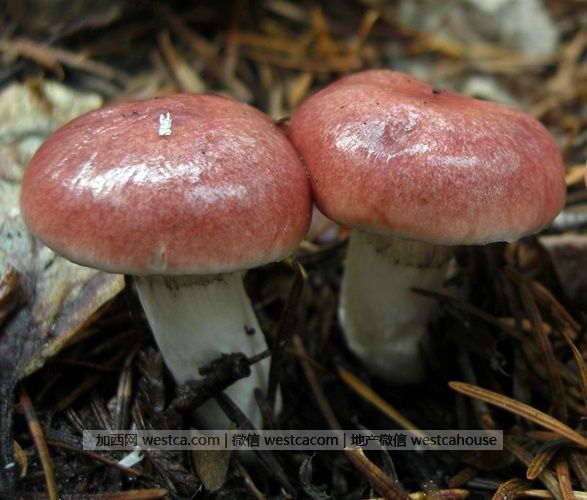
Saffron Milk Cap
Lactarius Deliciosus
cap is up to 15cm wide, convex shaped with an incurved margin, carrot-orange with greenish hues, sticky when wet. flesh is faintly tinted orange, greenish stains appear with age. gills are bright orange and descend on the stem, staining green. cutting the gills releases a carrot-colored latex that stains green. stem is light organge, staining green. grows singly or scattered in areas with conifers. appears in late sumer and fall. mild to slightly scrid taste with an indistinct odor; cook before eating. edible lookalike is Lactarius thyinos, which grows in northern cedar bogs and is similar in appearance but with a white stem, flesh that lacks green stains, and and an orange latex that stains red.
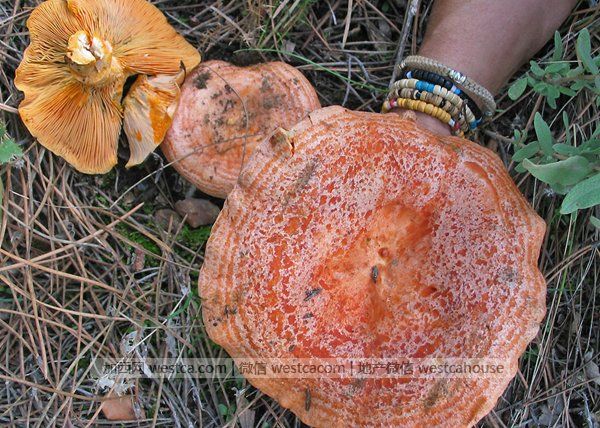
Scaly Hedgehog
Sarcodon Imbricatus
cap is up to up to 30cm wide, convex shaped with a depressed center, brown with raised scales and a dry texture. flesh is white or tinted brown. underside of cap has brown spines that descend onto the stem. stem is smooth and light brown, thickening towards the base. grows singly or as several in areas with conifers. appears in sumer and fall. taste is mildly bitter with no odor; cook before eating. an edible look-alike is the less-palatable Sarcodon scabrosus, which is similar in appearance but the cap is more reddish with scales that are not raised, and the stem is dark blue/black at its base.
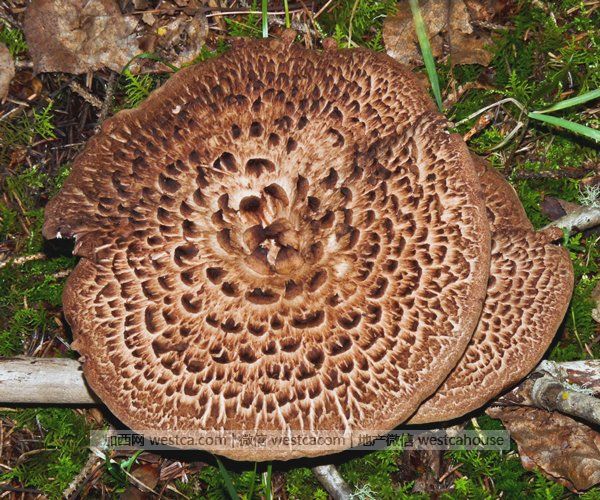
Shaggy Mane
Coprinus Comatus
cap is up to 15cm wide, narrow, cylidrical, white, and covered in thin, shaggy red/brown scales. older specimens have a cap that is bell-shaped. flesh is white, soft. gills are narrowly attached to the stem and white/grey when young. the flesh and gills of older specimens liquefies into a black inky mass. partial veil leaves an inferior, possibly moveable ring on the white stem. grows scattered or grouped together in grassy areas covering decomposing wood. appears in early spring and late fall. has a pleasant taste with no odor; cook before eating. an edible look-alike is Coprinus sterquilinus, which similar in appearance but smaller, with fewer scales and growing on dung. tip: collect younger specimens and/or remove blackening areas which have a more bitter taste. tip: cooking with water shortly after collecting helps to prevent the dish from turning into a black inky mess.
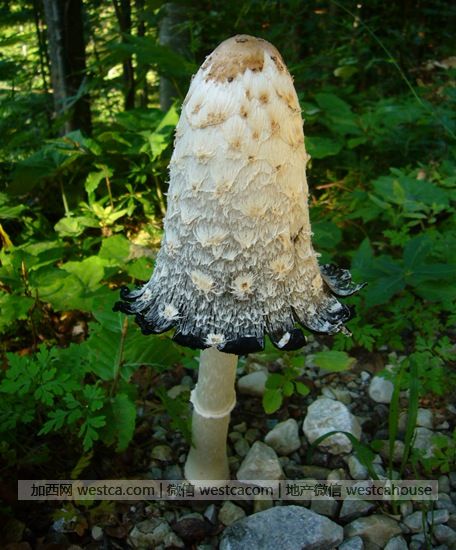
Slimy Spike Cap
Gomphidius Glutinosus
cap is up to 10cm wide, broadly convex shaped, smooth and sticky/slimy, cinnamon brown, possibly tinted purple/grey. older specimens have a planar cap with upturned margins. flesh is white and soft. gills are white, graying in age, and descend onto the stem. stem is white above and below the ring, with a distinct bright yellow area towards the tapering base. partial veil is thin, leaving a superior ring on the stem that soon turns black. grows abundantly in areas with conifers. appears in the summer and fall. has a pleasant taste with a mild odor; remove the cap's skin and cook before eating.
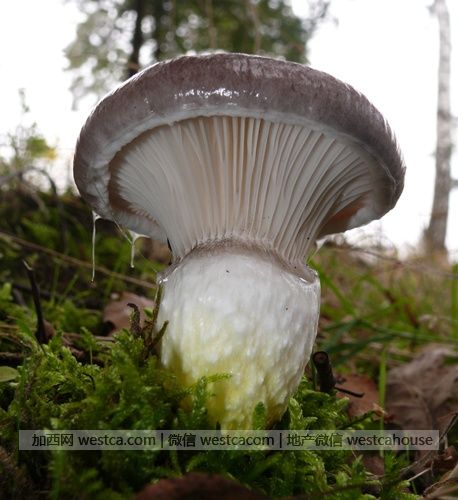
Western Giant Puffball
Calvatia Booniana
up to 60cm wide, widely oval with sculpured or scaled white exterior, possibly with a tannish tint. flesh must be firm and all-white. flesh must be undifferentiated with no trace of gills and no outline of mushroom visible in cross section. grows alone or several together in pastures or open, grassy, arid areas, often near sagebrush. appears in spring, summer and fall. has a mild pleasant taste with a strong/unpleasant odor when young; cook before eating.

Yellow Swamp Russula
Russula Claroflava
cap is up to 10cm wide, convex, smooth, bright/lemon yellow, dry. older specimens have a planar cap with a depressed center with small radiating furrow-lines at the cap-edges. flesh is white, soft, bruising grey. gills are yellow and directly attached to the stem. stem is dry, white, non-tapering, slowly bruising to grey/black. grows singly or as several under birch and mixed woods. appears in summer and fall. has a mild taste with no odor; cook before eating.
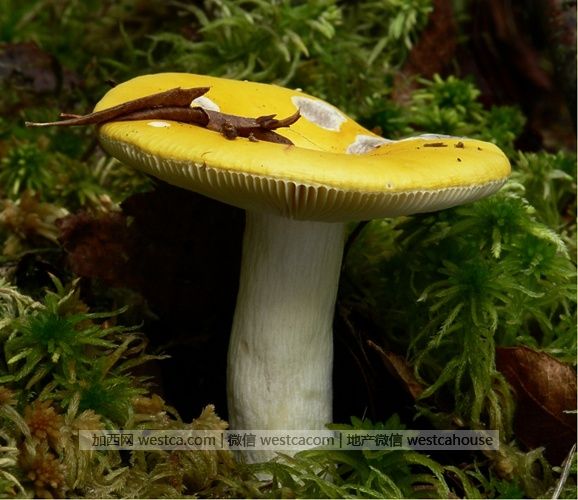
Yellow-gilled Russula
Russula Lutea
cap is up to 7cm wide, convex, smooth, bright yellow, sticky to the touch. older specimens have a planar cap with a depressed center with small radiating furrow-lines at the cap-edges. gills are brittle, yellow and attached directly to the stem. flesh is white, fragile, does not change color when bruised. stem is smooth, dry, white, non-tapering, not bruising grey. grows in groups or scattered under paper birch and other hardwoods. appears in summer and fall. has a mild taste with an apricot-like odor; cook before eating.
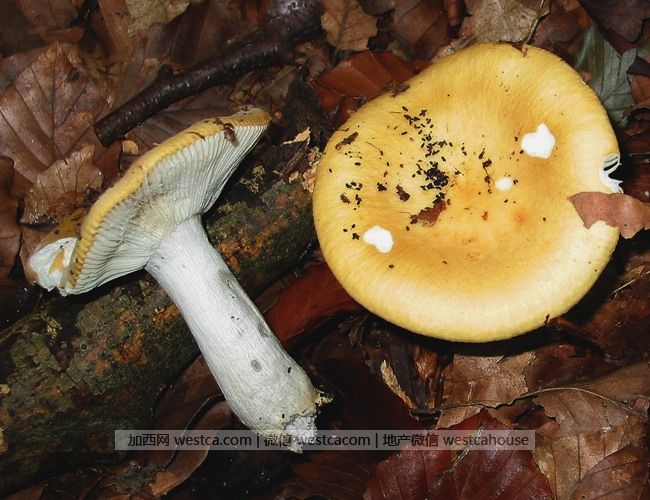
(在此感谢博友燕的分享)
本文从互联网中收集,版权归原作者所有。原作者有任何疑问请及时联系网站管理员,本站将立即予以纠正。
仅注册会员可以发表评论.
请登录或者注册 Powered by AkoComment 2.0! |

 主题旅游
主题旅游  一般性旅游
一般性旅游  温哥华有趣的野生蘑菇识别活动 图
温哥华有趣的野生蘑菇识别活动 图

 主题旅游
主题旅游  一般性旅游
一般性旅游  温哥华有趣的野生蘑菇识别活动 图
温哥华有趣的野生蘑菇识别活动 图